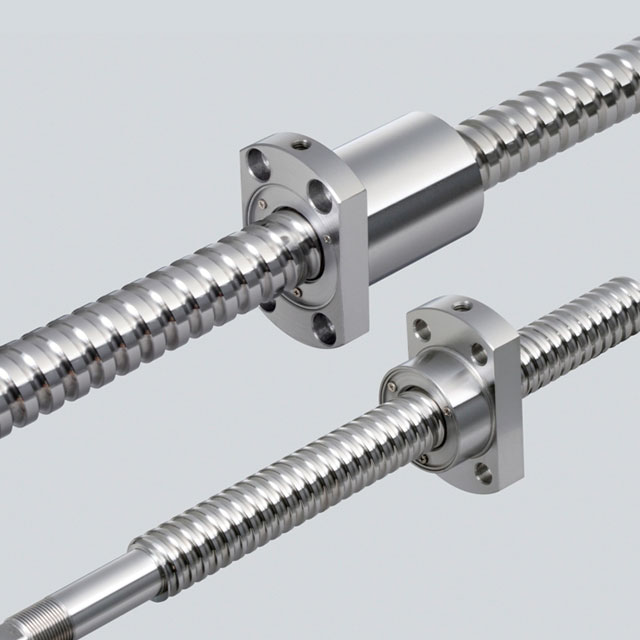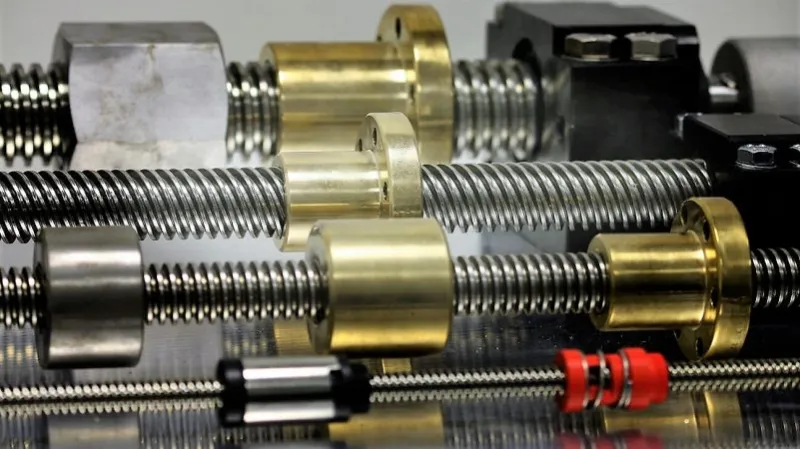Product Description
Sample Material:
Lead Screw – Stainless Steel;
Screw Nuts – POM.
Special specifications products can be customized according to the customer request
Hope you build up a long cooperation relationship with us; we will give you a discount and provide the free sample for your reference. Looking CHINAMFG to your inquiry.
| Products | Precision CNC machining parts | |
| Materials | Iron, aluminum, steel, copper, carbon steel, bronze, solder alloy, or as per the customers’ requirements. | |
| Dimensions | According to customer’ s drawing | |
| Surface treatment | Blacking, polishing, anodize, chrome plating, zinc plating, nickel plating, tinting or other as requirement. | |
| Packing | Bubble Bag, plastic bag, carton, plywood box, or as per the customer’ s requirements | |
| Standard | Such as ISO, DIN, GB, CHINAMFG and special standard | |
| Certificate | ISO9001: 2008 | |
| Processing equipment | CNC machine, CNC machining center, CNC cutting machine, radial drill, universal milling machine, high precision surface grinding machine, chamfering machine, etc. | |
| QC System | 100% during production check and random samples before shipment. | |
| Available | OEM, ODM | |
| MOQ | negotiable | |
| Ports | HangZhou or ZheJiang | |
| Delivery | Samples 7-15 days, batch production 30 days. |
CHINAMFG Transmission Technology is a professional manufacturer of lead screw, nuts, valve screw rod, worm and worm gear, which is used for transmission, lift, push-and-pull, fastening. We’re specialized in one-start lead screw, multi-start thread screw, left hand & right hand screw. Thread standard could be GB standard, German standard DIN103, American Standard ACME. The screw material could be carbon steel, alloy steel, stainless steel, copper, aluminum, etc.; nuts material could be brass, tin-bronze, Al-bronze, POM, carbon steel, cast iron, free-cutting steel, etc. Special specifications products can be customized according to the your request, including lead screws, nuts, M0.5-M6 modulus of the worm and the worm gear.
We have a full array of suitable equipment which is more than 250 sets, such as CNC lathe, machine center, milling machine, grinding machine, two-axis rolling and three-axis rolling, punching. Products are now more widely used in many areas. such as smart home, elderly chair, smart lifting table, smart door opener, smart window opener, smart lift, valve, farming machinery, sports equipment and so on. Our products are popular in domestic and foreign market. We mainly export goods to Europe, America and other international markets, which are well received by customers. Welcome come to visit our factory for business discussion, we will do our best to provide you with quality products and service.
/* March 10, 2571 17:59:20 */!function(){function s(e,r){var a,o={};try{e&&e.split(“,”).forEach(function(e,t){e&&(a=e.match(/(.*?):(.*)$/))&&1
| Material: | Stainless Steel |
|---|---|
| Type: | Round Head |
| Groove: | Trapezoidal |
| Connection: | Common Bolt |
| Head Style: | Round |
| Standard: | DIN, GB, ISO |
| Samples: |
US$ 1/Piece
1 Piece(Min.Order) | |
|---|
| Customization: |
Available
|
|
|---|

Can lead screws be customized for specific industries or machinery configurations?
Yes, lead screws can be customized to meet the specific requirements of different industries or machinery configurations. Customization allows for the adaptation of lead screws to unique applications, ensuring optimal performance and compatibility. Here’s how lead screws can be customized:
Thread Design:
The thread design of lead screws can be customized to suit specific applications. The thread profile, such as Acme, square, or buttress, can be selected based on factors such as load capacity, efficiency, backlash, and self-locking characteristics. The thread pitch can be adjusted to achieve the desired linear travel per revolution, allowing for different positioning resolutions. Custom thread designs can also be implemented to address specific requirements or constraints of the machinery configuration.
Materials and Coatings:
The choice of materials for lead screws can be customized based on the application’s environmental conditions and performance requirements. Different materials, such as stainless steel, carbon steel, or alloys, can be selected for their mechanical properties, corrosion resistance, or temperature resistance. Additionally, lead screws can be coated or treated with specialized coatings, such as Teflon or ceramic coatings, to reduce friction, improve wear resistance, or enhance lubrication properties.
Size and Dimensions:
The size and dimensions of lead screws can be customized to fit specific machinery configurations or space constraints. This includes variations in length, diameter, and thread length to ensure proper fit and integration within the machinery or system. Customization of lead screw dimensions allows for efficient utilization of available space and compatibility with existing components or mounting mechanisms.
End Machining:
Lead screws can be customized with different types of end machining to facilitate their connection to other components or power sources. This may involve the addition of keyways, flats, or other features to enable coupling with drive mechanisms, such as motors or handwheels. Customized end machining ensures proper alignment, torque transmission, and ease of installation within the specific machinery configuration.
Accessories and Attachments:
Customization of lead screws can also involve the addition of accessories or attachments to enhance their functionality or compatibility with specific industries or machinery configurations. This may include the inclusion of anti-backlash nuts, thrust bearings, lubrication systems, or wipers. These accessories and attachments can improve precision, reduce wear, increase load capacity, or address specific application requirements.
By offering customization options, lead screw manufacturers can cater to the diverse needs of different industries and machinery configurations. Customized lead screws ensure that the linear motion system is optimized for performance, efficiency, and compatibility, resulting in improved overall functionality and reliability.

What are the signs that indicate a need for lead screw replacement or maintenance, and how can they be diagnosed?
Lead screws, like any mechanical component, may require replacement or maintenance over time due to wear, damage, or performance degradation. Recognizing the signs of potential issues and diagnosing them accurately is essential for timely intervention. Here are some common signs that indicate a need for lead screw replacement or maintenance, along with diagnostic methods:
- Increased Backlash: An increase in backlash, which is the clearance or play between the lead screw and nut, can signify wear or mechanical issues. Excessive backlash can result in decreased accuracy and precision. Diagnosis: Backlash can be measured using specialized tools, such as dial indicators or laser displacement sensors. Comparing the current backlash with the manufacturer’s specifications can help determine if maintenance or replacement is necessary.
- Unusual Noise or Vibration: Unusual noises, vibrations, or excessive mechanical resonance during operation can indicate misalignment, worn components, or inadequate lubrication. Diagnosis: Careful observation and listening during operation can help identify abnormal noise or vibration. Inspecting the lead screw for signs of wear, checking alignment, and ensuring proper lubrication can help diagnose the underlying issue.
- Reduced Accuracy or Repeatability: If a lead screw system starts exhibiting decreased accuracy or repeatability in positioning, it may indicate wear, misalignment, or damaged components. Diagnosis: Conducting precision tests or comparing the system’s actual position with the desired position can help identify any inconsistencies. Inspecting the lead screw, nut, or associated components for signs of wear or damage can provide further insights.
- Increased Friction or Sticking: If the lead screw system experiences increased friction or sticking during operation, it may indicate inadequate lubrication, contamination, or worn components. Diagnosis: Observing the smoothness of the lead screw’s movement and checking for signs of lubrication deficiency or contamination can help diagnose the issue. Cleaning the lead screw and applying appropriate lubrication may resolve minor friction-related problems.
- Visible Wear or Damage: Visual inspection of the lead screw and nut may reveal signs of wear, corrosion, or physical damage. This can include worn threads, scoring, pitting, or deformation. Diagnosis: Regular visual inspection of the lead screw system is important to identify visible signs of wear or damage. If significant wear or damage is observed, replacement or repair may be necessary.
- Inconsistent or Jerky Movement: If the lead screw system exhibits inconsistent or jerky movement instead of smooth and controlled motion, it may indicate misalignment, binding, or damaged components. Diagnosis: Careful observation of the system’s movement, checking for misalignment, and inspecting the lead screw, nut, or associated bearings for signs of binding or damage can help diagnose the issue.
It’s important to note that proper diagnosis and decision-making regarding lead screw replacement or maintenance may require the expertise of qualified technicians or engineers familiar with the specific application and system requirements. Following manufacturer guidelines, maintenance schedules, and seeking professional assistance can help ensure accurate diagnosis and appropriate actions to maintain or replace the lead screw when necessary.

Can you explain the role of a lead screw in converting rotary motion to linear motion?
A lead screw plays a crucial role in converting rotary motion into linear motion in mechanical systems. It achieves this by utilizing the helical threads on the screw and the corresponding threads on the nut. Here’s a detailed explanation of how a lead screw accomplishes the conversion:
- Helical Thread Design: A lead screw is designed with a helical thread that wraps around its cylindrical shaft. The thread is typically a continuous spiral groove with a specific pitch, which is the distance between adjacent threads. The pitch determines the linear distance the nut will travel when the lead screw makes one complete revolution.
- Matching Threaded Nut: The lead screw is paired with a nut that has threads matching those on the screw. The nut is typically fixed in place while the lead screw rotates. The nut contains internal threads that engage with the external threads of the lead screw.
- Rotary Motion: When the lead screw is rotated, either manually or by a motor-driven mechanism, the helical threads on the screw cause the nut to move linearly along the length of the screw. The direction and magnitude of the linear motion depend on the direction and speed of the screw’s rotation.
- Linear Motion: As the lead screw rotates, the engaged threads between the screw and the nut create a force that translates the rotational motion into linear motion. The helical threads on the screw push against the matching threads in the nut, causing the nut to move along the length of the screw. This results in linear displacement of the nut and any attached components.
- Precision and Control: The pitch of the lead screw determines the linear distance traveled by the nut for each revolution of the screw. By controlling the rotational motion of the lead screw, precise and controlled linear movement can be achieved. This makes lead screws suitable for applications that require accurate positioning or adjustment of components.
- Load Capacity: Lead screws can handle both axial loads (tension or compression forces) and torque. The helical threads distribute the load over a larger surface area, allowing the lead screw to support and transfer significant loads. By incorporating thrust bearings or other supporting elements, the lead screw can handle high loads while maintaining smooth and controlled linear motion.
Overall, the lead screw’s role in converting rotary motion to linear motion relies on the interaction between the helical threads of the lead screw and the matching threads of the nut. This mechanism provides a reliable and precise means to translate rotational motion into linear displacement, making lead screws a valuable component in various mechanical systems and applications.


editor by CX 2024-01-11